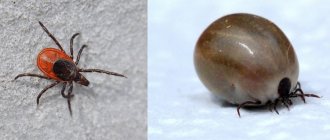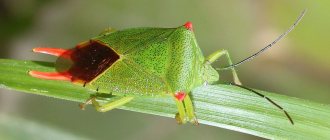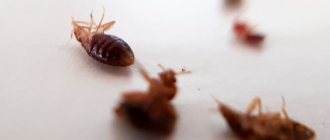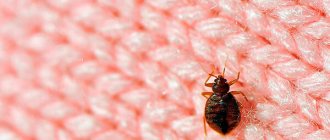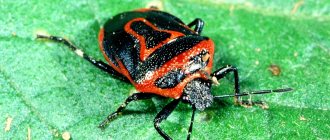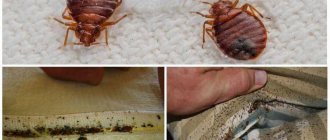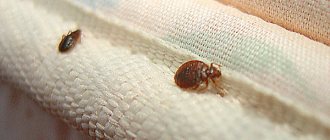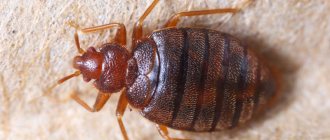- By Vil Malinoshevsky
- About bedbugs
Most people are sure that bed bugs nest in apartments and live only in sofas and beds. The assumption is logical, since parasites bite only at night, when their victims are sleeping soundly, nestled in their own beds. But it is fundamentally wrong to believe that bedbugs live only in sleeping places! Despite their small size, these insects are able to cover considerable distances. It is not difficult for an adult bedbug to run a distance of more than a meter in one minute. Therefore, the habitats of parasites are found throughout the apartment.
Very often people who live in infested apartments call us and say that they carefully examined sofas and beds, but could not find bedbugs, although they are sure that they are the ones who bite them at night. Our recommendations to look for nests in other places are received with surprise, because, in their opinion, bed bugs in an apartment should live in the bed.
It is because of such misconceptions that self-treatment at home often does not bring results. People cannot determine where bedbugs are hiding in an apartment and carry out incomplete or insufficient treatment of only sofas or only beds. As a result, it is not possible to completely get rid of parasites. Some bedbugs will definitely survive after such disinfestation, and everything will return to normal. After just a short period of time, you will have to fight pests again.
The fact is that even if it was possible to destroy those bedbugs that settled in the sofa, those that live in other places in the room quickly multiply and their descendants safely populate the sofas and beds again. Each female lays more than 500 eggs in her life, and she lives no longer than a year. So we count – over 40 eggs per month! What if there are a hundred such females? Such calculations give me goosebumps...
Signs that there are bedbugs in the apartment
It is quite easy to understand that there are bedbugs in the house based on the following signs:
- bites on the human body (bugs do not bite animals, but can move on their fur);
- a specific smell (similar to sour raspberry jam or cognac of dubious quality);
- waste products in places where bedbugs accumulate: dead insects, dried feces the size of a poppy seed;
- small blood stains on the bed linen.
What does a bug bite mark look like?
Bedbugs constantly feed on blood.
An adult insect bites several times in order to get enough, which is why marks called “tracks” appear on the skin. At the moment of the bite, the bug injects an anesthetic under the victim’s skin, so the person does not feel discomfort. But in the morning the wound turns red, swells and begins to itch. There can be many marks on the body, because absolutely the entire population feeds on blood, and each insect feeds once every 6-10 days. In the center of the bite mark there is always a noticeable dot - a wound with a small bump in the middle. Traces of a bedbug attack cannot be confused with mosquito bites. In addition, they attack silently and all year round, and not just in the warm season.
If bedbugs bite even during the day, it means there are so many of them that the entire population simply does not have time to get enough during the night.
Does a bedbug carry infections?
It is believed that the bug does not infect the victim immediately at the moment of its bite; scientists have not been able to detect pathogens of dangerous diseases in its saliva. But they are present in the digestive tract and excrement, so the contamination of rice is still very high. Bedbugs can transmit tularemia, brucellosis, smallpox, hepatitis B, tuberculosis, typhoid fever and anthrax to you.
To reduce the risk of infection, in the morning you need to wash off all bedbug excrement from the skin with soap and water and treat the wounds with a chlorhexidine solution. Bites can be lubricated with any anesthetic ointment: Lidocaine, Menovazine, Fenistil.
Unpleasant smell
An apartment with bedbugs has a special smell: something between sour raspberry jam and cheap cognac. Sometimes residents get used to it and don’t feel it, but experienced exterminators can determine by smell where exactly bedbugs are hiding and in what quantity.
Evidence
If you turn over the mattress of a bed or sofa and find the following traces, you need to start fighting parasites without delay:
- brown hard skins of larvae;
- larvae;
- eggs;
- chitinous skins of larvae;
- excrement;
- dead insects
Another evidence of the presence of bedbugs in the apartment are small spots of blood on the bed linen. A well-fed bug becomes clumsy and slow, and, tossing and turning in their sleep, people crush them - hence the blood stains. A hungry bug is nimble and nimble; it will not be possible to accidentally crush it also because it has a hard chitinous shell.
13) Curtains and drapes
The presence of bedbugs on curtains and curtains is difficult to explain logically. But for some reason these objects attract insects. Most of all, parasites like to sit in the daytime on the upper zone of curtains and drapes, preferring poorly lit folds and, especially often, seams. The small dimensions of the bug allow it to effectively hide even in thin fabric.
In this case, it is possible to detect insects thanks to traces of their vital activity in the form of dark dots or small blurred spots. They are especially noticeable on fabrics of light colors and shades. In any case, when preparing for disinsection, you should definitely inspect all the curtains, drapes and drapes used in the apartment or house.
Where and how do bedbugs live in an apartment?
The bug lives from 12 to 14 months. He needs to feed on blood regularly, about once every 5 to 10 days. If food becomes unavailable, the insect goes into suspended animation and lives in this state for more than a year, even at low temperatures. In search of food, insects migrate through ventilation ducts, along the outer walls of houses, and can move by settling on the fur of an animal. On their own, the imago (adult bug) travels 1 m in a minute, and the nymph (young individual) - up to 25 cm.
Adults do not tolerate sudden drops or increases in temperature. Like the larvae, at -17°C they do not live longer than a day. At temperatures from +45°C and above, adults and larvae die after 45 minutes.
Bedbug, I'm coming to look for you!
If you are convinced that parasites live in your home, find out where their colonies are concentrated. They do not have nests like ants, but they live in groups in the most comfortable places for these insects.
The “bed” bug lives next to its breadwinner. For proper nutrition, he needs the person to sleep soundly and not move. The bloodsucker only bites in open places; it does not go under pajamas or blankets. Therefore, it settles in a mattress or in the upholstery of upholstered furniture. Ectoparasites do not live in bedding because it is changed, washed and ironed.
Where to find a bedbug at night?
From 3 to 8 am the parasites go hunting.
If you turn on the light suddenly, they can be seen in the bed next to the victim. Individuals who have not yet drunk quickly retreat, and those that are well-fed will slowly crawl back into their burrows. Trying to get rid of ectoparasites by night “catching” is pointless. You will have to forget about sleep, and the insect population will recover very quickly. You won’t catch them all, because they feed once every few days, which means that someone will hide in a shelter, and the larvae, when they grow up, will replace the destroyed adults.
A third of the bedbug colony lives in the box spring, frame and slats of the bed. It's warm, dark and there's a person nearby. In addition, people rarely look under the mattress, which means it will be difficult to declassify their nest.
Where do bedbugs hide during the day?
During the day, a small population of bloodsuckers hides in the mattress. If there are a lot of bedbugs, they have to settle in new places. Most often they settle in:
- upholstered furniture;
- cracks between furniture, walls and floors;
- under baseboards;
- in curtains;
- in carpet pile;
- in the nightstand by the bed;
- in sockets;
- behind the paintings;
- under linoleum;
- behind the battery;
- in electrical appliances;
- behind a layer of peeling paint on the walls;
- between books.
These are the places where you need to strike the main blow!
Where do bedbugs like to live?
Bloodsuckers inhabit the back side of the sleeping area. If there are holes in the upholstery of a sofa or bed, it will be very convenient for insects to hide there. A foam mattress is an ideal place: it is warm, there is enough air, and the pores are comfortable for laying eggs. If not the entire population fits on the back side of the bed, some have to live in the armrests, drawers and on the sides, pushed towards the wall.
All furniture with foam layers is suitable for ectoparasites to live in: ottomans, chair-beds, pillows. In wooden furniture, they hide in cracks and joints, waiting for the night, and the females lay eggs. The larvae do not lay on metal and tiled surfaces.
10) Decorative elements and finishing
Bedbugs willingly use any building structures that have depressions and cracks or are loosely adjacent to the wall, floor or ceiling as hiding places. First of all, in this situation we are talking about baseboards - floor or ceiling, false coverings, suspended ceilings, door and window frames and other similar decorative and finishing elements, found in large numbers in any residential premises.
Even peeling wallpaper or peeling paint can unpleasantly surprise the inhabitant of an apartment or house with dozens of bedbugs located inside. Joints, cracks or other defects in the flooring also often become a favorite place for the parasite to spend the day. The easiest way to combat insects in such a situation involves not only pest control, but also high-quality repairs that eliminate or reduce the likelihood of a recurrence of the problem in the future.
How to get rid of bedbugs in an apartment?
For the operation to be successful, you need to determine where exactly the bedbugs live. To do this, bring diluted alcohol or a decoction of tansy to the suspected places of their accumulation. Dissatisfied bloodsuckers follow the smell. The locations are indicated to the exterminator.
Traditional methods
Centuries-old practice of combating ectoparasites suggests methods such as extreme temperatures and exposure to odors.
Heat treatment
At temperatures below -15°C, bedbugs die. But the result will be achieved only if this temperature is maintained for a couple of days. Furniture, carpets and pillows with bedbugs are taken out into the cold for several days. The optimal result can be achieved if you purposefully cool the apartment for several days. This method will not work in a city apartment: due to central steam heating, the temperature will not drop to the required level.
The steam generator kills insects using high temperature. A small number of bedbug infestations can be removed using steam.
Bedbugs that hide in curtains and bedding can be removed by washing and ironing.
The disadvantage of the temperature method is that by acting on mature individuals, the larvae may not be destroyed and after some time the invasion will repeat.
Scare away with smell
Ectoparasites do not like the smells of lavender, tansy and wormwood. But it will not be possible to destroy them in this way. Herbs will certainly repel bedbugs that want to move away from the neighbors. To do this, hang tufts of grass on the adjacent wall and near the vents.
Professional disinfection
The use of chemical insecticides gives the best results. But it is important to choose the right drug and apply it to the places where bloodsuckers live. An incorrect dosage calculation can lead to human poisoning, or it will be insufficient to eliminate insects and will only build their immunity.
Conclusion
The above top 15 places where bedbugs prefer to hide during the day clearly shows the preferences of parasites. They love secluded places where it is dark, warm and there is minimal likelihood of contact with a person at an inappropriate time for the insect.
Using the rating, you can carry out the most effective and quick search for parasites in an apartment or house, which is a mandatory preparatory step before protective treatment of housing. Moreover, knowledge of the actual habitats of bedbugs will allow disinfestation to be carried out with maximum efficiency, guaranteeing relief from an unpleasant neighborhood for a long time. Before treatment, be sure to check where bedbugs are hiding in your apartment.
Chemical means to control bedbugs
- Aerosols are effective against bedbugs, but are dangerous for humans. You need to spray strictly on insects, wearing a respirator and a protective suit. After the procedure, wash your hands and face with soap. Popular remedies: Dichlorvos, Tetrix, Insecticide, Executioner.
- The powders kill insects within three days. The dust is destructive to adults and nymphs, but has no effect on bedbug eggs.
- Pencil crayons are not dangerous to humans, but they only repel insects and do not destroy them. Clean House, Titanic and Mashenka will make it clear to the bedbugs that they are not welcome here if they happen to drop by for a visit.
It will not be possible to eradicate a large population of ectoparasites on your own. The struggle takes time and effort, toxic substances affect people living in the apartment, and money is spent on purchasing drugs that will never give the desired result.
A pest control specialist identifies the habitats of insects, determines the size of the population and competently uses the optimal long-term exposure drugs.
Bring in the fog
Using special equipment, the exterminator creates cold and hot fog. The chemical, in the form of a cloud of steam, fills the apartment, making its way into the most secluded corners. During the spraying process, all adult bedbugs immediately die, and after disinfection, the substances act for about a month and bring death to the new generation that hatched from the moment the “fog” was sprayed.
14) Computer system unit
household appliances any habitat for bedbugs. Much more it attracts other unpleasant neighbors of humans from among insects - cockroaches. However, there are many cases where parasites were found inside various household equipment. Most often, in such a situation we are talking about either a microwave oven or a computer system unit.
These types of household appliances heat up during operation; there are quite a few dark places inside the structure; in addition, the devices are constantly used by humans, who emit carbon dioxide during breathing, which bedbugs really like. The result of all these factors is that the parasite chooses a system unit or a microwave oven as a hiding place.
Common questions about bedbugs
Is it enough to throw away a sofa in which bedbugs live to get rid of them?
No. Most likely, insects have inhabited not only the sofa. Of course, if the sofa is old and riddled with bedbugs, you should throw it away, but to be sure that the insects will not sit under the baseboards or behind the closet waiting for a new sofa, it is worth treating the room.
What temperature kills bedbugs?
A temperature of +50°C almost instantly kills bedbugs at all stages of development. Adults die at temperatures below -20°C and above +45°C. The larvae die at -17°C.
Is it possible to accidentally bring a bedbug home?
Yes. Bloodsuckers may accidentally come to you along with someone else's household appliances or upholstered furniture. Since purchasing used items always carries a risk of infection with bedbugs, they should be treated with an insecticide before bringing them into the apartment.
Can bedbugs live inside an orthopedic mattress?
The size of the insect does not allow it to penetrate inside the mattress. But if the cover is torn or has holes, the bug will infest all layers of the mattress.
In what cases do bedbugs appear again after treatment?
- if the insecticide was chosen incorrectly and live insects remained in secluded places;
- if your neighbors’ apartment is infested with bedbugs and they don’t poison them;
- if the eggs were not killed, young larvae will hatch from them 5-7 days after treatment
This is why treatment against bedbugs often has to be repeated 2-3 weeks after the initial extermination.
If you need a guaranteed result, call the phone number listed on the website or fill out the feedback form. The company’s specialist will advise you on the exact cost of the service and book a specialist visit on a date and time convenient for you.
We are ready to promptly exterminate hated insects 24 hours a day, seven days a week!
2) Bed frame
As a rule, wood is used to make a load-bearing bed frame. The design is a set of individual parts and provides for the presence of numerous joints, fastener locations and other secluded places where bedbugs like to hide during the day. Often, various boxes, shoes and other items are stored under the bed or inside the furniture, which are also used by parasites for shelter.
Finding insects in the bed frame will require removing bedding and removing the mattress, and in some cases, turning over or disassembling furniture into individual parts. In most situations, finding bedbugs will be possible without problems, although it will require a lot of time and effort. In any case, when parasites are detected, the bed in general and the frame in particular must undergo protective treatment.
We use traps
Knowing that bedbugs go out hunting every night, you can try to protect your bed (if they have not yet taken up residence on the frame itself). You can buy ready-made traps or make them yourself.
- You can purchase ready-made traps from Hector, which are installed under the legs of the bed.
The meaning of this trap is that the bug, having climbed to the top along the outer rough side of the trap, encounters an obstacle in the form of a groove with a slippery surface. An insect thirsty for blood cannot understand in time that its legs are unable to grasp such a surface. Trying to get through the obstacle, the bug slides down, from where, for the same reason, it cannot get up. - Adhesive double-sided tape around the legs of the bed can also keep pests out. A few bugs may stick, but most will find a way around it.
- Vaseline makes the legs of a bed frame too slippery to climb on.

